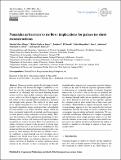Files in this item
Nunataks as barriers to ice flow : implications for palaeo ice sheet reconstructions
Item metadata
| dc.contributor.author | Mas e Braga, Martim | |
| dc.contributor.author | Jones, Richard | |
| dc.contributor.author | Newall, Jennifer | |
| dc.contributor.author | Rogozhina, Irina | |
| dc.contributor.author | Andersen, Jane | |
| dc.contributor.author | Lifton, Nathaniel | |
| dc.contributor.author | Stroeven, Arjen P. | |
| dc.date.accessioned | 2023-05-03T10:30:03Z | |
| dc.date.available | 2023-05-03T10:30:03Z | |
| dc.date.issued | 2021-10-25 | |
| dc.identifier | 284170789 | |
| dc.identifier | 5b39283e-d73f-46bb-819d-04bb62f989d7 | |
| dc.identifier | 85118279760 | |
| dc.identifier.citation | Mas e Braga , M , Jones , R , Newall , J , Rogozhina , I , Andersen , J , Lifton , N & Stroeven , A P 2021 , ' Nunataks as barriers to ice flow : implications for palaeo ice sheet reconstructions ' , The Cryosphere , vol. 15 , no. 10 , pp. 4929-4947 . https://doi.org/10.5194/tc-15-4929-2021 | en |
| dc.identifier.issn | 1994-0416 | |
| dc.identifier.other | ORCID: /0000-0002-4843-1876/work/133728679 | |
| dc.identifier.uri | https://hdl.handle.net/10023/27493 | |
| dc.description | Funding: This research has been supported by the Vetenskapsrådet (grant no. 2016-04422), the Deutsche Forschungsgemeinschaft (grant no. 1158-365737614), the National Science Foundation (grant no. OPP-1542930), and the Norsk Polarinstitutt (grant no. 2015/38/7/NK/ihs). | en |
| dc.description.abstract | Numerical models predict that discharge from the polar ice sheets will become the largest contributor to sea-level rise over the coming centuries. However, the predicted amount of ice discharge and associated thinning depends on how well ice sheet models reproduce glaciological processes, such as ice flow in regions of large topographic relief, where ice flows around bedrock summits (i.e. nunataks) and through outlet glaciers. The ability of ice sheet models to capture long-term ice loss is best tested by comparing model simulations against geological data. A benchmark for such models is ice surface elevation change, which has been constrained empirically at nunataks and along margins of outlet glaciers using cosmogenic exposure dating. However, the usefulness of this approach in quantifying ice sheet thinning relies on how well such records represent changes in regional ice surface elevation. Here we examine how ice surface elevations respond to the presence of strong topographic relief that acts as an obstacle by modelling ice flow around and between idealised nunataks during periods of imposed ice sheet thinning. We find that, for realistic Antarctic conditions, a single nunatak can exert an impact on ice thickness over 20 km away from its summit, with its most prominent effect being a local increase (decrease) of the ice surface elevation of hundreds of metres upstream (downstream) of the obstacle. A direct consequence of this differential surface response for cosmogenic exposure dating is a delay in the time of bedrock exposure upstream relative to downstream of a nunatak summit. A nunatak elongated transversely to ice flow is able to increase ice retention and therefore impose steeper ice surface gradients, while efficient ice drainage through outlet glaciers produces gentler gradients. Such differences, however, are not typically captured by continent-wide ice sheet models due to their coarse grid resolutions. Their inability to capture site-specific surface elevation changes appears to be a key reason for the observed mismatches between the timing of ice-free conditions from cosmogenic exposure dating and model simulations. We conclude that a model grid refinement over complex topography and information about sample position relative to ice flow near the nunatak are necessary to improve data–model comparisons of ice surface elevation and therefore the ability of models to simulate ice discharge in regions of large topographic relief. | |
| dc.format.extent | 19 | |
| dc.format.extent | 6084332 | |
| dc.language.iso | eng | |
| dc.relation.ispartof | The Cryosphere | en |
| dc.subject | GB Physical geography | en |
| dc.subject | DAS | en |
| dc.subject | MCC | en |
| dc.subject.lcc | GB | en |
| dc.title | Nunataks as barriers to ice flow : implications for palaeo ice sheet reconstructions | en |
| dc.type | Journal article | en |
| dc.contributor.institution | University of St Andrews. School of Geography & Sustainable Development | en |
| dc.identifier.doi | https://doi.org/10.5194/tc-15-4929-2021 | |
| dc.description.status | Peer reviewed | en |
This item appears in the following Collection(s)
Items in the St Andrews Research Repository are protected by copyright, with all rights reserved, unless otherwise indicated.

